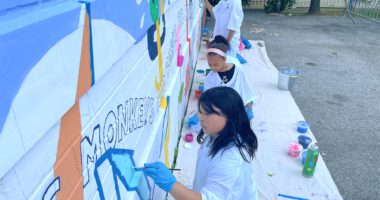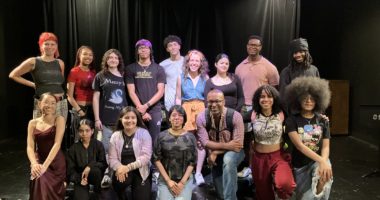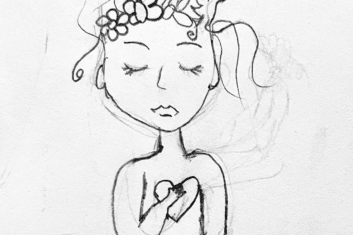In this ongoing series, Katie Rainey, reports from inside the Teaching Artist Training and Internship Program. A graduate of the program, Katie shares her insight into the workshops, seminars and personal experience with classroom internships.
On Saturday, November 22nd, 2014, Community-Word Project’s Teaching Artist Training & Internship Program (TATIP) had its fourth workshop. In this workshop the new trainees took the helm and essentially ran the show. The trainees, many for the first time, took turns presenting a co-planned and co-taught lesson plan to the other participants. There was a wide variety of collaborations between artists and media, as well as inventive new takes on what it means to teach art in the classroom.
Tiffany Nesbit and Kadeem Gayle started us off with a writing lesson aimed at getting kids to really hear the things they say, think about, and write about. It was a lesson in realistic dialogue and action, and empathy in writing. They had us free write real arguments between two people. We took those and turned them into sketches, tweaking the dialogue to play out as a script. We performed these skits in the last part of the lesson and the results were outstanding. It seemed as if real arguments were happening all around us. We ended with a serious reflection on dialogue and the major and minor things about which people argue.
Next, we had a theatre lesson aimed at fostering community in the classroom and exploring self-expression and identity. The exercise was led by Amanda LaPergola, Ally Tufenkjian and Frank Moran. Their lesson centered on bringing a Shel Silverstein poem to life. The participants each took turns reading a line from the poem “Whatif”. They discussed how we related to the poem by giving a gesture to our particular line in the work. It was interesting to track the reactions of the group. Participants fostered an immediate bond by relating to the same line in the poem. The trainees main activity called for a group collaboration to bring the poem to life with participants using a variety of media: visual art, sound, and movement.
Kim Baglieri and Dan Paul Roberts brought the work of two artists to their classroom: Henry Matisse and Kerry James Marshall. They reminded us how important it is to introduce artworks by successful artists to demonstrate that art is something that also lives outside the classroom. It prompts students to think about their personal, creative elements. Their main activity was an exercise called “My Dream Room”. Students are asked to create collages with things that they imagine are in their dream room. At the close of the lesson, they put a twist on the traditional Community-Word Project closing by relating it back to their lesson. The call and response:
I have a vision! My vision has power! My vision can change the world!
Katie Cox and Laura Epperson got our logistical brains ticking with a little musical-numbers game. They introduced the concept of nonverbal communication in music and composition by having the group close their eyes and stamp their feet to a certain tempo. Eventually, the participants meandered around the room (carefully of course! Everyone had their eyes closed still) until they found someone else keeping time to the same tempo. Keeping with the theme of nonverbal communication, their main activity had the participants break off into groups and collaboratively, nonverbally act out Shel Silverstein’s poem “Backward Bill”.
Marlie Decopain and Megan Skelly had the group thinking about compassion and empathy in their communities through the power of visual art and poetry. They redirected our creative thinking by starting out with a quote from Albert Einstein.
A human being is part of a whole, called by us the ‘Universe’ —a part limited in time and space. He experiences himself, his thoughts, and feelings, as something separated from the rest—a kind of optical delusion of his consciousness. This delusion is a kind of prison for us, restricting us to our personal desires and to affection for a few persons nearest us. Our task must be to free ourselves from this prison by widening our circle of compassion to embrace all living creatures and the whole of nature in its beauty.
This put us in the collective brain space for interacting and feeling as a community. The objective was to raise awareness of space and its collaborative importance to composition. It also got us working as a community to build a “living composition”. Marlie and Megan passed out white frames and instructed the participants to arrange themselves within these frames. It was a fresh and exciting community-building activity that sparked our creativity. Their main activity combined their two art forms, creative writing and visual arts. Participants brainstormed metaphors from their own lives, and then translated those into a work of visual art.
Paco Marquez and Javan Howard took the term “kinesthetic learning” to a whole new level with their twist on words and movement. Javan peaked our interest when he asked the group, “How does an ‘O’ roll?” Participants teamed up and went through the alphabet, acting out each letter as if it could move, figuring out what those movements might look like. They were given words to spell using their bodies while the rest of the class guessed what words they formed. They transitioned quickly to a lesson on metaphors that encouraged students to think about the literary device in their everyday lives. They put an interesting spin on their closing reflection by asking everyone to say what letter of the alphabet they felt like at that moment and why.
We had another trio combine their artistic forces for this next lesson: Cristal Rodriguez, Christina Shedeler and Lawrence Malu. They combined the power of poetry and the visual arts to teach students about alliteration. They used family and diversity as creative elements for the base of this activity. They got the participants warmed up and thinking about these elements by having them arrange themselves silently into different “families,” asking them, “How does a family look?” “How does a big family look?” “How does a small family look?”
For their main activity, they had the participants draw their families and what that meant to them. They gave a quick lesson on adjectives and had the participants list adjectives to describe their families. A portion of the time was dedicated to writing poems to accompany these pictures, using repetition or anaphora to make the poem resonate with the reader.
Finally, Felix Morez and Tanya Minhas closed out the presentations with a lesson in visual arts that highlighted their theme of exploration in your neighborhood. They opened their lesson with a fun warm up in which the trainees called out what they wanted to be when they “grew up”. Then, they introduced the participants to two artists, Edward Hopper and Vincent Van Gogh. Felix also did something that can make a powerful impact on students, he shared his own work. It’s always good for students to learn about famous artists. And it can be just as meaningful for them to be introduced to a regular person creating art. It can bring art closer to them and keep it from becoming this large thing that feels impossible. They centered their main activity around community by combining poetry and the visual arts, which is something we value at CWP. We strive to help students become more aware of their communities and the impact that their voices can make.
“Co-creating a lesson plan with another artist provided many self-revelations. It was wonderful to be able to brainstorm and fine tune the lesson with another creative mind.” – Tanya Minhas, Visual Artist
Although the trainees held the reins for the majority of the day, CWP’s lovely and talented Program Director, Megan Morrison, helped co-facilitate the seminar part of the day with our fearless leader, Patti Chilsen. Together, they provided vital feedback about each lesson presented in order to help the trainees better communicate their artistic visions with a classroom of students.
Our next and final seminar before the trainees enter CWP classrooms as interns will take place on Saturday, December 6, 2014.



